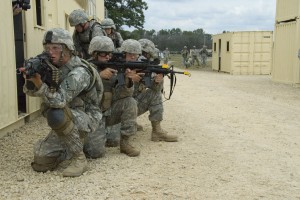
Army ‘funding cliff’ may mean more demand for deployments, reserve soldiers
The Army likely will look to the National Guard and Army Reserve to fill steady-state missions as it deals with increasing demands for soldiers around the world.
“The demand for Army forces has really been pretty high,” said Maj. Gen. Gary Cheek, the Army’s assistant deputy chief of staff for operations. “The velocity of global instability has really got us concerned that we’ll have a problem both with capacity as well as capability, and the readiness to do that.”
Many of the missions the Army is responding to – containing the Ebola outbreak in West Africa, coordinating the mission in Iraq and providing assurance and deterrence in Europe in the face of Russian aggression – were “not anticipated,” Cheek said Friday while speaking to reporters at the Pentagon.
Seven of the Army’s 10 division headquarters are committed, Cheek said, even as the Army faces a “funding cliff” if sequestration returns that will have a “huge impact on capacity and readiness.”
As it looks to an unpredictable future, both in funding and contingencies around the world, the Army has different versions of the budget based on whether sequestration returns.
The Army is now working to get the active force to an end strength of 490,000, but its directive after 2015 is to get to 450,000, Cheek said.
If sequestration returns, the Army will only be able to pay for an active force of 420,000, said Brig. Gen. Frank Muth, director of the Army Quadrennial Defense Review Office in the Army resource management directorate.
“The bill payer is ultimately going to come out of readiness,” Cheek said. “This is the challenge we have. We see this world environment, where you have this global instability, and the demands for us are growing. We think the numbers don’t match the missions you’re asking us to do.”
Those demands also place stress on soldiers, Cheek said.
“You may see the Army continue to accomplish missions, but underneath that you may have a soldier deploying every other year or worse, or if there’s a major contingency, there may not be a rotation,” he said. “Our soldiers are great soldiers, and they’ll salute and drive on, but how long can we ask that of them?”
The strain on the active force, which is being cut to 490,000 by the end of fiscal year 2015, with even deeper cuts to come after that, means the Army will probably end up calling on the Guard and Reserve.
The Army “considers them always” to fill different mission requirements, Cheek said about the reserve components.
The challenge, however, lies with accessing those forces for non-contingency operations, he said.
“If there is not a funding authority, we have to find the money for pay and allowances, so that makes it more difficult for something that’s not an overseas contingency-type of requirement,” Cheek said.
Also, the reserve component typically performs best when they have advanced notice and a specified mission, he said.
“We don’t believe they’re well suited for a no-notice-type mission,” he said.
That means the Army likely will look to the Guard and Reserve for long-term, steady-state missions such as Kosovo peacekeeping operations or Multinational Force of Observers in the Sinai, Cheek said.
In recent years, those two deployments have fallen to the active Army for budgetary reasons, but leaders are now looking to program reserve-component troops for Kosovo and the Sinai again, Cheek said.
The demands on the force, coupled with the looming return of sequestration in 2016, has Army leaders speaking out about the impact of these cuts on readiness, training, modernization and acquisition.
Since 2011, the Army has canceled 21 acquisition and modernization programs, delayed 125 and restructured 124, for a total of 270 programs directly affected by changes in the budget, Muth said.
If sequestration returns, 137 more programs will be affected each year, he said.
“If we go to sequestration, we’re looking at a $14 billion decrement off the FY14 funding we’d have to absorb,” he said.
The budget cuts can only come from a limited number of places, Cheek said.
“The manpower accounts, we have to pay, but we have a budget that’s not built for the number of soldiers in the Army,” he said. “Now we have to look at training or research and development programs.”
Last year, the Army had to cancel several combat training center rotations, leading to a severe decline in readiness, Cheek said. The Army made back some of that readiness – increasing it by 50 percent – in fiscal 2014 thanks to the Bipartisan Budget Act, which restored more than $1 billion in the Army’s readiness accounts, he said.
Those rotations are expensive – about $30 million each – but they are critical to ensuring brigade combat teams are ready for the full spectrum of operations, he said. The Army is going to try and maintain its CTC rotations in fiscal 2016, which may then result in less home station training, he said.
“We’ve got some real challenges in ’16,” Cheek said. “If we do go through sequestration, that good year we’ve had in ’14 will vanish, but it’ll also create a hole or a debt that’ll take a few years to recover from. It’s a real concern that has some real implications for us.”
A key concern shared by senior Army leaders is making sure soldiers are properly trained and ready for the missions they’ve tapped to perform, Cheek said.
“Things are going to take longer, your likelihood of casualties is going to be higher,” he said. “It’s not necessarily mission failure, but we believe, as the Army, our job is to make sure every soldier we put into combat we’ve trained him or her to the highest level of preparedness that we can.”
On any given day, the Army has nine or 10 brigade combat teams engaged around the world, Cheek said.
There soldiers in Korea, Afghanistan, the Middle East, Africa, Europe and the Pacific, he said.
The demand for aviation soldiers also remains “extraordinarily” high, complicating an already complex Army aviation restructuring, said Col. John Lindsay, director of aviation for the Army G-3.
The five-year restructuring calls for the Army to divest its fleet of the OH-58 Kiowa Warrior helicopter and use the AH-64 Apache to fill the Kiowa’s reconnaissance and scout role.
The Army would pull Apaches from the National Guard inventory to fill the gap, and, in turn, provide the Guard with UH-60 Black Hawk helicopters.
The plan has been controversial among some Guard advocates, but Army officials said it’s necessary to save money and retain a ready, effective aviation force.
To date, one OH-58 squadron – 4-6 Attack Reconnaissance Squadron of Joint Base Lewis-McChord, Washington – has been inactivated, and the conversion of the Apache from the D-model to the E-model is ongoing, Lindsay said.
Training for new Kiowa officers, warrant officers and enlisted soldiers has been terminated, and the Army has identified the “majority” of existing Kiowa soldiers for transition to another airframe, he said.
The Army also has started to transition its training fleet at Fort Rucker, Alabama, to the LUH-72 Lakota from the TH-67, Lindsay said.
The restructuring plan also calls for the Army to cut three of its 13 active-duty combat aviation brigades; the reserve component will retain its 12 aviation brigades.
The inactivations are a “work in progress,” Lindsay said, because of the demand for these forces, but the cuts have to be made to fit the Army into a shrinking budget.
The Army hopes lawmakers end sequestration, which is “really the root of all the issues,” Cheek said.
Otherwise, the Army’s end-strength, modernization and readiness will remain out of balance at least until 2019, and it’ll take even longer, as many as four more years, to fully recover, he said.
“We would come into that fiscal year with a readiness deficit … that we wouldn’t be able to drop money to fix,” he said. “The time length of the effects of sequestration go way beyond just getting through ’16 and ’17. It’ll take a long time for us to pull out of that.”
SOURCE: Town Talk
BY: Michelle Tan




